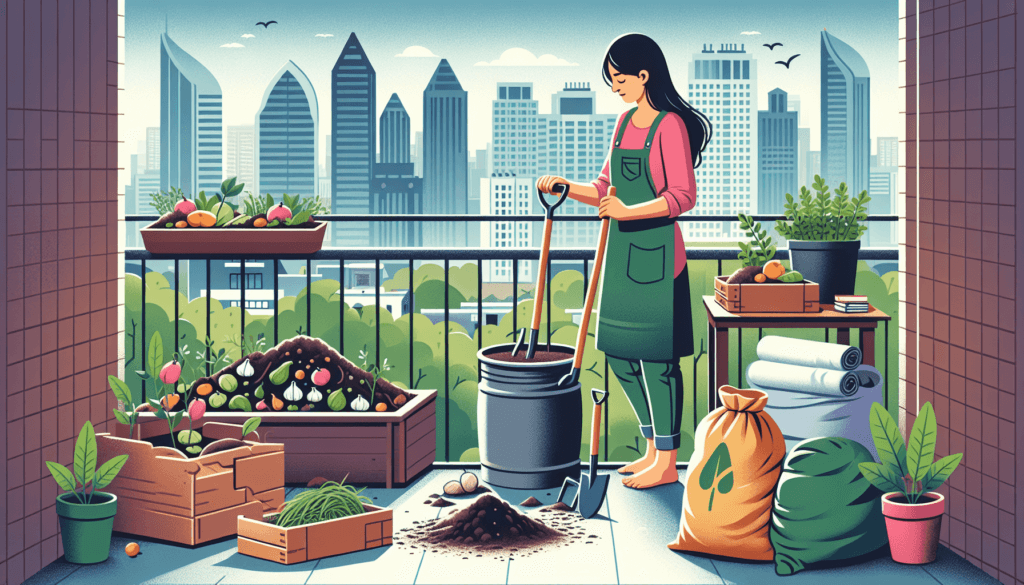Are you looking to improve the soil quality in your urban garden? Look no further! In this article, we will explore simple and effective do-it-yourself methods to enhance the fertility and health of your soil. Urban gardening can present unique challenges, but with these easy techniques, you can create a flourishing oasis in the heart of the city. Whether you’re a seasoned gardener or just getting started, these tips and tricks will help you achieve vibrant and bountiful harvests in your urban oasis. So grab your gardening gloves and let’s get started!

Choosing the Right Location for Your Urban Garden
When it comes to urban gardening, choosing the right location is essential for the health and success of your plants. Consider sunlight exposure as one of the primary factors in selecting the perfect spot for your garden. Most vegetables and herbs need at least six hours of direct sunlight per day, so make sure the area you choose receives adequate sunlight.
Additionally, evaluate the drainage of the location. Poor drainage can lead to waterlogged soil and root rot, hindering the growth of your plants. Look for a spot that allows water to drain away easily, preferably on a slight slope or with well-draining soil.
Lastly, assess the proximity to buildings and trees. Buildings can cast shadows, obstructing sunlight, while trees can compete for nutrients and water. Choose a location that is away from large buildings and trees that may overshadow your garden and hamper its growth.
Test Your Soil
Before you begin gardening, it’s crucial to understand the state of your soil. Conducting a soil pH test is the first step in this process. It will provide valuable insights into the acidity or alkalinity of your soil, helping you determine which plants are best suited for your garden. pH testing kits are readily available and easy to use.
In addition to pH, analyze the texture of your soil. Sandy soil drains quickly but may not retain nutrients well, while clay soil can become compacted, hindering root growth. Loamy soil, which is well-draining and nutrient-rich, is ideal for most plants. Understanding the texture will guide you in making appropriate amendments to improve soil structure.
Lastly, determine if your soil has any nutrient deficiencies. A soil test can identify deficiencies in essential nutrients like nitrogen, phosphorus, and potassium. These deficiencies can adversely affect the growth and health of your plants. Soil testing can be done professionally or through DIY kits available at local gardening centers.
Composting
Composting is a fantastic way to improve soil quality and reduce waste. Starting a composting pile involves collecting organic matter such as vegetable scraps, coffee grounds, and yard waste. These materials, when composted, add vital nutrients and improve soil structure.
Begin by collecting kitchen scraps like fruit peels, coffee grounds, eggshells, and vegetable scraps. Avoid adding meat, dairy products, or oily substances, as they can attract pests and slow down the decomposition process.
Next, add yard waste like leaves, grass clippings, and small branches to your compost pile. This green matter provides nitrogen, an essential nutrient for plant growth. Remember to shred or cut larger items into smaller pieces to accelerate decomposition.
Monitor your compost pile regularly, ensuring that it remains moist but not waterlogged. Turn the compost occasionally to aerate it and speed up the decomposition process. Over time, your compost pile will break down into dark and crumbly compost, ready to be added to your garden beds.
Mulching
Mulching is an effective technique that helps conserve moisture, suppress weed growth, and improve soil quality in urban gardens. Choose appropriate mulch materials based on availability, climate, and the specific needs of your plants. Organic materials like straw, shredded leaves, and wood chips are commonly used for mulching.
Once you’ve selected your mulch, apply it to your garden beds. Spread a layer of mulch around your plants, ensuring there is a gap around the stem to prevent rot. Mulch should be applied to a depth of 2-4 inches, allowing for sufficient moisture retention and weed suppression.
Monitor and maintain your mulch regularly. As the mulch decomposes, it adds organic matter to the soil, improving its fertility. Over time, the mulch layer may thin out, so make sure to replenish it as needed. Additionally, be mindful of any weed growth that may push through the mulch and remove them promptly to prevent competition for nutrients.

Intercropping
Intercropping involves planting different crops together in close proximity to maximize space, improve soil health, and deter pests. When selecting compatible plant combinations, consider the growth habits, nutrient requirements, and pest resistance of each plant. For example, planting tall and sturdy plants next to weaker ones can provide support and shade.
Practice succession planting by staggering the planting of crops throughout the growing season. This method ensures a continuous supply of fresh produce and prevents the depletion of nutrients from the soil. As one crop nears maturity, another can be planted, optimizing the use of limited garden space.
Implement companion planting by pairing plants that benefit each other. For example, planting marigolds near vegetables can deter harmful pests with their strong scent. Similarly, growing beans near corn provides natural nitrogen fixation, benefiting both plants.
Intercropping not only enhances the overall productivity of your garden but also aids in soil health by creating a diverse ecosystem that promotes beneficial insect activity and reduces pest problems.
Crop Rotation
Crop rotation is a technique that involves systematically changing the location of crops from year to year. This method offers numerous benefits, including reducing pest and disease issues, improving soil fertility, and preventing nutrient depletion.
To practice crop rotation effectively, it’s crucial to understand the plant families to which your crops belong. Different plant families have varying nutrient requirements and are prone to specific pests and diseases. By rotating crops within these families, you can mitigate pest and disease pressures.
Plan your crop rotation by dividing your garden into sections and assigning a specific family of plants to each section. Rotate these sections annually to ensure that the same family does not occupy the same space for consecutive years. This practice breaks the life cycles of pests and diseases that may have overwintered in the soil.
During the planning process, take note of specific pest and disease issues you have encountered in the past. This information will help in determining which crops to avoid planting in the affected area and aid in maintaining the health of your garden.

Cover Crops
Cover crops, also known as green manure, are an effective way to improve soil quality during the off-season. Choose appropriate cover crop species based on your climate, soil type, and specific goals for your garden.
Sow cover crops once the main growing season is over. Ideal cover crops include legumes like clover and vetch, which fix nitrogen in the soil, and grasses like rye and barley, which help with weed suppression and moisture retention.
Incorporate cover crops into the soil before they reach maturity to prevent them from competing for nutrients with your main crops. Cut the cover crops down and till them into the soil. As they decompose, they release nutrients, add organic matter, and improve soil structure.
Cover crops not only protect your soil from erosion and compaction but also provide a valuable source of nutrients, improve water infiltration, and suppress weed growth.
Organic Amendments
Using organic amendments is an excellent way to improve soil fertility and structure. Compost, a well-rotted mixture of organic matter, is one of the most common organic amendments used in gardens. It improves soil structure, adds nutrients, and enhances moisture retention.
Consider other organic options such as vermicompost, which is the byproduct of worm digestion. Vermicompost is rich in nutrients and beneficial microorganisms, making it a valuable addition to your soil.
Apply amendments according to the results of your soil test. If your test reveals nutrient deficiencies, apply compost or other organic amendments accordingly. Take care to follow the recommended application rates to avoid over-application, which could harm your plants.
Regularly adding organic amendments to your soil will gradually improve its overall health, leading to healthier plants and increased yields.

Watering Techniques
Proper watering techniques ensure that your plants receive the right amount of water without wasting this precious resource. Water deeply and infrequently by providing a thorough soaking to encourage deep root growth. This method promotes drought tolerance and minimizes the risk of surface evaporation.
Consider using appropriate watering methods such as drip irrigation systems. Drip irrigation delivers water directly to the plant roots, minimizing water loss due to overspray or evaporation. It is also more efficient and precise, reducing the risk of overwatering.
Avoid overwatering and waterlogging, as excessive moisture can lead to root rot and other plant diseases. Regularly monitor the moisture levels of your soil and water only when necessary. Use your finger or a soil moisture meter to determine if watering is required.
By practicing proper watering techniques, you will conserve water, enhance plant health, and optimize the growth and productivity of your urban garden.
Conclusion
In conclusion, there are numerous DIY ways to improve soil quality in urban gardens. Consider the location of your garden in terms of sunlight exposure, drainage, and proximity to buildings and trees. Test your soil to understand its pH, texture, and nutrient deficiencies. Start composting to enrich your soil with organic matter and nutrients, and mulch your garden beds to conserve moisture and suppress weed growth.
Utilize intercropping, crop rotation, and cover crops to maximize space, improve soil health, and deter pests. Incorporate organic amendments like compost and vermicompost to further enhance soil fertility. Practice proper watering techniques to ensure your plants receive adequate moisture without overwatering.
Remember that ongoing monitoring and maintenance of your soil are crucial for long-term success. Start implementing these techniques, and watch your urban garden thrive!



